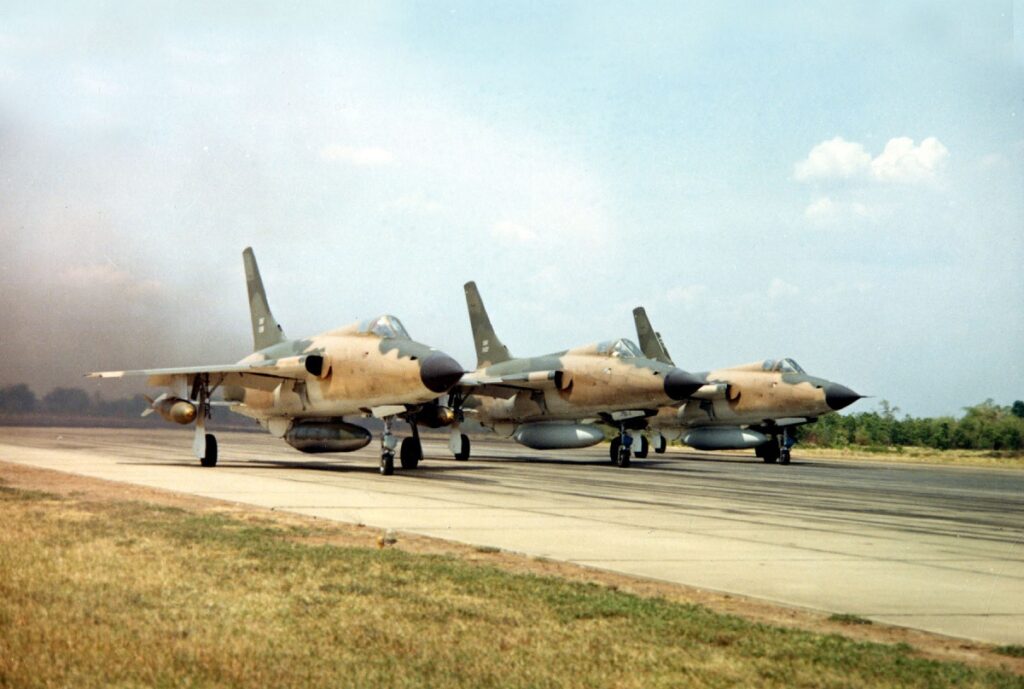
Born in South Bend, Indiana, on May 2, 1926, James H. Kasler moved with his family to Birmingham, Alabama, at the age of eight, by which point he was already fascinated by the heroes of the past and by adventure and wargames. At 17 he was keen to become a pilot, so he took the aviation cadet examination, but World War II was nearing its end so he was not needed as a pilot. Offered the choice of becoming a gunner or navigator instead, Kasler chose the tail gunner course, training in B-24s and then serving on B-29s on Tinian Island. He flew a few missions over Iwo Jima and Japan before returning home and re-joining the aviation cadet program and qualifying as a pilot in 1951.

As explained by Peter E. Davies in his book USAF F-105 Thunderchief Vs VPAF MiG-17, Kasler flew F-80s and F-84B/Cs, which he described as ‘horrible airplanes,” and then the F-86A – he made a supersonic dive in a Sabre that damaged the flying surfaces so much that the fighter had to be written off. Assigned to the F-86E-equipped 4th Fighter Interceptor Group at Kimpo during the Korean War, he became an ace on May 15, 1952 after shooting down his sixth MiG-15. Three of these aircraft, he later discovered, were flown by Soviet pilots. His combat experiences in Korea during the course of his 101 missions left him with great respect for the MiG, which could fly considerably higher than the F-86 and could therefore allow its pilot to choose whether or not to engage American fighters in combat.
Assigned to the USAF’s Nellis-based Fighter Weapons School postwar, Kasler tested the first six F-100As (‘the worst airplane I have over flown’) and contributed to its development into the successful F-100D. He converted to the F-105 and joined the 36th TFW at Bitburg, and was subsequently posted from there to the Takhli-based 354th TFS/355th TFW in February 1966 as operations officer — Kasler was one of the first three USAFE F-105 pilots to be sent to Southeast Asia.
On Jul. 19, 1966, he led four F-105 flights from 354th TFS/35Sth TFW tasked to target a petrol, oil and lubricants (POL) storage site near Hanoi. The aircraft were supported by two F-4C MiGCAP flights and an EB-66 radar jammer, which had F-104C escort. Kasler and his wingman 1Lt Steve Diamond (in F-105D 59-1755) were at 4,000ft heading towards their target, having already evaded four SAMs and AAA, when Diamond saw five MiG-17s near Noi Bai. Kasler’s flight jettisoned their ordnance and he turned to fire at Nguyen Van Bien’s leading 923rd FR MiG-17, which quickly turned behind him, starting a strenuous 15-minute dogfight. The MiGs subsequently made seven firing passes at him and Diamond. Bien’s wingman Vo Van Man fired at Diamond, who in turn damaged Bien’s MiG. Other F-105s intervened, driving off some MiGs, but Diamond’s aircraft was fatally damaged by Man. Diamond ejected from his blazing Thunderchief as the biggest aerial conflict of the war to date continued (when Kasler himself was shot down on Aug. 8, 1966, his captors stated that Diamond had died of a ruptured spleen).

Kasler became the only member of the USAF to be awarded the Air Force Cross three times, including one for leading POL strike on Aug. 8, 1966 that saw him shot down by ground fire while trying to locate and protect his wingman, 1Lt Fred Flom, who had ejected earlier in the mission (Kasler’s 91st). He had received “hero” coverage in the American press during, the Korean and early Vietnam wars (Kasler had been labeled “the hottest pilot” in Vietnam in an article published in Time Magazine’s August 1966 edition), which contributed to the consistently brutal treatment he subsequently received during his 2,401 days as a PoW in Hanoi.
James Kasler retired from the USAF with the rank of colonel in 1975. He passed away on Apr. 24, 2014, aged 87.
